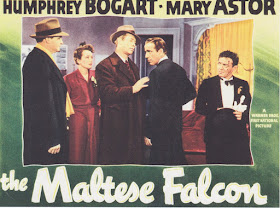Often discussed as the first film noir, The Maltese Falcon is beyond doubt, a masterpiece. It has been placed at #23 in the 100 Years, 100 Films; #26 in their list of 100 Years, 100 Thrills, #6 in their Top 10 Mystery films. It was one of the first films entered into the National Film Registry. Even back in 1941, New York Times reviewer Bosley Crowther was singing its praises, especially for the Humphrey Bogart's "excellent revelation of character". At the 14th Annual Academy Awards, it scored three nominations: Best Picture (losing to How Green Was My Valley. I make no comments here. I LOVE How Green Was My Valley. Plus, it was a tough year to pick just one best picture.), Best Supporting Actor (Sydney Greenstreet, who lost to Donald Crisp in How Green Was My Valley), and best adapted screenplay for John Huston (who lost to Here Comes, Mr. Jordan. Yes - I love that movie too).
Mary Astor was also nominated that year, but not for her role as Bridget O'Shaughnessy/Miss Wonderly. In 1941, she also appeared as the bitchy concert pianist, Sandra Kovak in The Great Lie. She was nominated as Best Supporting Actress for that film, and won.
When you see The Maltese Falcon on a big screen, some little, but interesting things pop out at you. As Spade walks down the street, we see a movie theatre marquee behind him. Playing at the theatre - The Great Lie! A little product placement by Warner Brothers? It's small, but you can see it in the image below. The Great Lie was released in April of 1941; The Maltese Falcon in October.
This was Sydney Greenstreet's (Kasper Gutman) first film role - he was 62 at the time. He began his career on the London stage (in 1902). By 1905, he was in America. and from 1907 through 1940, he appeared in 30 Broadway plays, including the works of Shakespeare (As You Like It, The Merchant of Venice, The Merry Wives of Windsor), Chekov (The Seagull), Ben Jonson (Volpone), and Oscar Wilde (Lady Windemere's Fan). Though both the British and American film industries approached him to enter the medium early on, he refused until he was signed by Warner Brothers for our film. Paired with Peter Lorre (Joel Cairo) for the first time in The Maltese Falcon, the two would become a virtual team, eventually appearing in 9 films together. Between 1941 and 1949, when he retired, Greenstreet appeared in 54 films, including Christmas in Connecticut, The Woman in White (where he does a magnificent Count Fosco), Flamingo Road, They Died with Their Boots On, and Devotion. He died in 1954, the result of diabetes, aged 74.
Another thing that was very noticeable on a big screen was the reaction of Wilmer, aka the Gunsel (Elisha Cook Jr.) to Gutman's intention to give him over to Spade as a scapegoat. Wilmer is crying as he attempts to escape from the apartment. The he original Dashiell Hammett novel hints at an intimate relationship between Wilmer and Joel Cairo. That Cairo (and Gutman) would be willing to sacrifice him to Spade is perhaps part of the motivation for his reaction - and subtly hints at a subject the film would not have been able to tackle.
Kudos to Lee Patrick as Effie Perine, the indomitable secretary to Spade and Archer. Effie is no fool - she knows everything that is going on in the office, but also knows how to keep a secret. Her loyalty to Spade is boundless, yet we don't have the requisite lover pining for the man who doesn't notice that she's alive. Effie likes Spade, but she knows who he is, and also knows he's not likely to fall for her. And she seems just fine with that.
These TCM articles point out that George Raft was (again) slated to star in the role that eventually went to Bogart. The film, being handled by a new director, was not important enough for Raft's taste (and was he ever wrong!). Edward G. Robinson was also briefly considered. Thankfully, though Warner's decided that Bogart's star was on the rise (he'd just had a huge success with High Sierra), and gave him the part. Bogart is quoted as saying that The Maltese Falcon "was practically a masterpiece. I don't have many things I'm proud of but that's one." A fascinating array of actresses were considered for the role of Bridget: Olivia de Havilland, Loretta Young, Rita Hayworth, Paulette Goddard, Brenda Marshall, Janet Gaynor, Joan Bennett, Betty Field and Ingrid Bergman (AFI Catalog), and Lee Patrick was originally considered for the part of Iva Archer (which eventually went to Gladys George), with Eve Arden a first choic for Effie.
When a film has the acclaim that this one has, physical objects which represent it become iconic. The Black Bird that Bogart holds at the end of the film is one of those items. In this recent Vanity Fair article, the tale of the elusive bird, which sold at auction for $4.1 million, is detailed. You'll also find a slide show about the Falcon.
We'll leave you with this opening sequence from The Maltese Falcon, and the question - would you trust this woman?





No comments:
Post a Comment
Thanks for your interest in this blog. Your comments will be moderated to minimize spam to the website. Thanks for understanding.